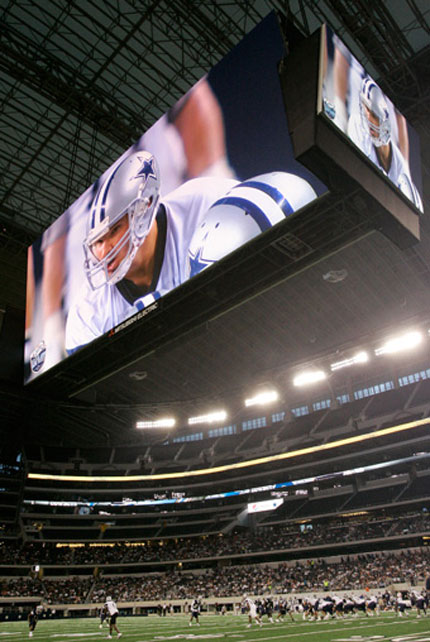 The centerpiece of Cowboys Stadium, Arlington, Texas. Photo by AP Photo/Tony Gutierrez
The centerpiece of Cowboys Stadium, Arlington, Texas. Photo by AP Photo/Tony GutierrezThere are many exciting moments in your typical NFL game. A running back, disregarding all self-preservational instinct, leaps headfirst over a pile of linemen and lands in the end zone. A linebacker nearly decapitates some rail-thin wide receiver flashing across the middle. Cheerleaders return from halftime wearing new outfits. A punt, however, does not generally quicken one’s pulse. Punts are the prelude to a commercial break, a moment to pause and consider that next beer, or to wonder if it’s worth bathing today.
So when A.J. Trapasso, the Tennessee Titans’ backup punter, stepped onto the field during a sleepy preseason game in Dallas this August, it’s likely that nobody was expecting anything out of the ordinary. In fact, there were probably very few eyes on Trapasso when the football boomed off his foot. That’s because Trapasso was kicking in the Dallas Cowboys’ bombastic new $1.2 billion stadium, an ultra-opulent temple built to honor owner Jerry Jones’s great loves — football, the Cowboys, and conspicuous consumption. The fans in attendance were probably looking at anything besides the punt — the “world’s largest operable glass doors,” for instance, which can be found at the far end of the stadium, and through which the entire field slides on a set of tracks when non-football events are held at the stadium.
Even more likely, they were gawking at a very, very large scoreboard — the 160-foot-long, 1.2 million pound, Mitsubishi Diamond Vision true HD display, that is the centerpiece of Cowboys Stadium. This is a spectacular object, this scoreboard. It cost, by itself, twice as much to build as the previous Cowboys Stadium. It is maintained via a ten-level internal scaffolding system and its use requires the services of a full-time, highly trained operations team. Its display capacity is equal to 4,920 52-inch flat panel televisions, and it is illuminated by 30 million pulsing light bulbs. In short, it makes your typical Jumbotron look like a 13-inch TV/VCR.
But the devil, as they say, is in the details. As Trapasso’s otherwise ordinary kick neared its apex, the ball ricocheted off the bottom of the screen and dropped to the turf like a duck shot from the sky. That was not supposed to happen.
Someone hung the damn scoreboard too low.
Confusion took hold that evening in Dallas. Titans coach Jeff Fisher challenged the play, claiming interference, and the referees kind of shrugged their shoulders, not exactly sure how to proceed. You see, there is little precedent for such events in the NFL rulebook, mostly because no team had ever constructed a scoreboard the size of Rhode Island.
How, you might ask, could such a colossal oversight come to pass? How could someone install a $40 million scoreboard and not take into consideration the fact that games are played beneath it? Was it hubris? Incompetence? An honest mistake? These questions are irrelevant. The NFL ruled afterwards that the Cowboys do not have to raise the scoreboard until the season has ended. For this one season, games played in Dallas will be some weird mashup of football and pinball. And believe it or not, this is a good thing.
To understand why, you must understand the spirit of the NFL, which is cold and steely, like a refrigerator door. In the NFL, unregimented behavior, peculiar attitudes — these things are frowned upon. Players wearing the wrong-colored cleats are fined heavily. Acts of self-expression are strongly discouraged: in order for Bengals wide receiver Chad “Ochocinco” Johnson to wear his nickname on the back of his jersey, he was forced to legally change his last name to…Ochocinco. Unlike baseball, with its pastoral traditions and idiosyncratic ballparks, professional football is a game of stark uniformity. This is manifested most significantly in the design of NFL stadiums. Giants Stadium, the Superdome, the old Astrodome, and even the newer stadiums in Philadelphia and Baltimore — all massive, soulless, interchangeable bowls, possessing no distinct visual identity. Of course, this is no accident. Football, America’s great and mighty game, is played in these stadiums. If you want bells and whistles, go ride a Schwinn.
But now…now there is this massive, wonderful, ill-conceived scoreboard in Dallas, looming over the field like the Death Star, deflecting punts and infuriating coaches and giving you, the viewer at home, something new and innocuous to get excited about. “Look at that stupid thing,” you’ll say. “It’s too damn big! Those guys in Dallas, they’re idiots.”
But you won’t be changing the channel during a punt.


Comments [22]
09.14.09
09:21
Schwinn went belly up in 2001.
btw- I used to live at the end of Jerry Jones Street in Big D's Turtle Creek. What a pathetic, womanizing loser. RIP: Tom Landry.
09.14.09
10:02
09.14.09
11:16
No more, I promise.
09.14.09
11:55
I just spent a week in Dallas and Fort Worth. Believe me, down there they think there is only one "Big D" and it ain't Detroit, partner.
09.14.09
12:05
http://www.youtube.com/watch?v=fjx6vsR71sg
09.14.09
02:57
09.14.09
04:07
09.14.09
04:08
09.15.09
04:56
Your article is typical of a blogger or writer that has no real world experience or a quest to research the facts or the reasons behind a statement or action. Your only response is to jump to an un-educated conlusion.
09.15.09
02:34
you are correct. this post is "god awful." i thought it was good, and the editors of this site obviously must have too, but you have proven us all wrong.
you'll be pleased to know that, as of right now, i am quitting writing. and it's because of you, and your excellent comment. many thanks for shaking me of my delusions. you are like the world's best guidance counselor.
humbled,
john cantwell
09.15.09
03:24
That being said I feel that the author missed an important element of the current conversation. Both sides agree there is a problem with the placement of the scoreboard. Neither side wants to pay the million plus dollars to fix it. This is a classic scenario of guidelines being followed and then the discovery of problems with those guidelines as innovative solutions were implemented. Seems like a common design/client problem to me.
I gotta disagree with you when you say the NFL is stark and uniform. Players celebrate routine plays in the NFL more often than any other professional sport. Every tackle, dropped or made pass gets a mini celebration. If you celebrated that much in the NBA or MLB you'd have 12 hour games.
09.16.09
02:42
I just finished reading Daniel Borstein's "The Image: A guide to Pseudo-Events in America" and this is exactly the kind of thing he outlines. (a brief explanation of a pseudo-event is something that is contrived, planned for or otherwise non-spontaneous) We have a football game going on right in front of us and yet most people will spend the time at the game watching the television.
We don't experience "the real" anymore. And designers (for the most part) are allowing our skill and ability to be used by those who seek to perpetuate the pattern of the creation of deceptive pseudo-events.
The problems with the scoreboard getting in the way aside, this is just another example of how we are being disconnected the more we are connected and allowing ourselves to be deceived -- no, asking and demanding that we be deceived.
Go read the book. If you disagree that the very implementation of this billboard constitutes a pseudo-event, then we need to talk.
09.17.09
02:19
many thanks for your comment. you are right to bring up the idea of "pseudo-events" and there are, indeed, a few valid questions that this post never addresses. Such as:
- is such a large screen necessary, at all
- what are the implications of having such a large screen at a live sporting event?
it is definitely curious that jerry jones, the cowboys' owner, would spend so much on a lavish arena for fans to watch live football and then make the centerpiece of the stadium a television screen. in some ways, it seems as though he has simply created the most expensive place possible for cowboys fans to watch television. in this regard, the new stadium seems almost like a product of a recently bygone era. back in 2006, before the markets crashed, we might not have questioned - and maybe would have applauded - such an ostentatious feature. but now it seems kind of silly.
but, still, there are other factors to consider. for one, the new cowboys stadium does not only host football games. it is the site of concerts and, eventually, college basketball games. with this knowledge in mind, the giant screen makes much more sense. if i'm a rock fan living in the dallas area, i'm much more enthused about seeing a future U2 concert at the new stadium knowing this scoreboard is there, because it will provide me with views that no other large stadium offers. same goes for a college basketball fan sitting in the last row of the upper deck for a final four game.
and there are still other potential applications for the scoreboard that have not been tested. imagine going to see the latest hollywood blockbuster at cowboys stadium, with 80,000 other people. there would be a certain excitement to that, for sure.
this essay did not allude to these facts because i was particularly interested in how the new scoreboard would affect the games and how the scoreboard related to the general typology of nfl stadiums. nevertheless, the questions that a scoreboard of this size raises are certainly worth considering in our present time, and are likely to grow more pressing in the years ahead.
09.17.09
10:52
09.18.09
03:37
09.18.09
11:24
09.18.09
11:41
you're right - the screen was hung above the minimum required height. the problem, though, is the screen's length. a shorter scoreboard hung at the same height would almost certainly not interfere with play. but because the scoreboard is 160 feet long, it needs to be hung higher in order to avoid the trajectory of punted balls.
09.18.09
12:47
That screen, and jumbo screens at sports events serve a very important purpose for fans at a game. It enhances the experience. It gives people in the nosebleeds a chance to be fully engrossed in the game. This stadium holds over 100 thousand people. There is no seat in that house good enough to see game details. If anything this screen enhances the live experience by bringing in the best elements of staying home to watch it on HD television, combined with the atmosphere of a real game. This is the ultimate sports fanatic's dream experience.
No fan has a good enough seat to see a close play, or read the number on the jersey of that player who just made the great play. No one has the ability to turn back time and see an instant replay on their own. Those scoreboards enhance the experience. They will come in very valuable during the playoff push as fans want to know what's going on with the games being played by division rivals. Professional sports are entertainment meets spectacle.
Conceptually this scoreboard is completely appropriate for where it is installed. Its in Dallas, Texas where everything is bigger, for a franchise that has been calling itself "America's Team" for over 30 years. To have anything less self indulgent would be a design failure.
09.18.09
12:54
09.19.09
03:31
@Chris - not only was it "America's Team," it was also "God's favorite team" (hence the hole in the top of Texas Stadium, the Cowboys' former home, so God could watch them play. Unfortunately for God, Jerry Jones has cancelled His season tickets.)
As a former Dallasite, I loved this article - it made me laugh out loud, knowing that often, we live up to our stereotypes.
10.16.09
01:59
01.05.10
11:10